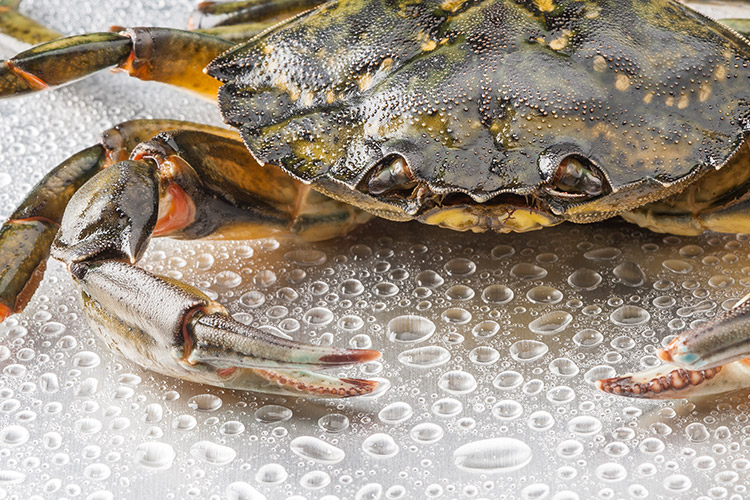Chitosan: A bioplastics breakthrough

“In 2020, I think we almost have a moral obligation to try to use the ingenuity, the curiosity, the immense luck we have as researchers to help with the big challenges of humanity,” says McGill University’s Dr. Audrey Moores. While molecules are right in this green chemist’s wheelhouse, Dr. Moores strives to keep the bigger picture in focus. The Moores Research Group was working with various polymers – materials formed from long and repeated chains of molecules, like plastics and glass – when they struck the thought of using biomass to create an advanced biopolymer.
86% of all plastics in Canada end up in landfills, making a naturally-produced alternative to traditional plastics an appealing prospect. Cue chitosan: this biodegradable polymer is derived from chitin, a natural substance found in abundance in the shells of crustaceans. Heralded for having immense structural possibilities, one might wonder why chitosan-based material isn’t the current posterchild for environmentally conscious products. Look no further than the actual transformation of chitin into chitosan, a harsh and polluting process that involves heating up corrosive liquids to yield any results. Dr. Moores says, “It’s bad for workers in the factory manipulating those solutions, and it’s bad for the environment because you release a lot of polluted waste water.”
Upon seeing the potential in chitosan, her research group decided to approach the unsustainable transformation process using mechanochemistry and aging, a technique of molecular synthesis carried out in a solid state without solvents, meaning that no corrosive liquids at intense heats are necessary. Their trials resulted in a brand new material that has completely new properties, all while requiring substantially less water, eight times less sodium hydroxide, and three times less energy to produce. Key elements to this patented process include a resting and aging period and high humidity levels, reducing the risk factor for factory workers considerably. Not only are safety and environmental risks addressed, but Dr. Moores sees bioplastics as a compelling avenue for this new biopolymer’s applications, adding to the sustainable advantages of the discovery.
News of this breakthrough reached mainstream media when Gabrielle Beaulieu, Project Manager from Parks Canada, approached Dr. Moores in the hopes of collaborating to solve a problem. Nova Scotia’s Kejimkujik Seaside National Park has fallen victim to the invasive green crab, a nosy crustacean that tears up eelgrass on the seabed in search of food. Eelgrass patches serve as nurseries for a lot of marine life, and as feeding grounds for migratory birds. “Destruction of the [eelgrass] has led to massive effects on the ecosystem around it,” explained Dr. Moores, who visited the seaside herself to witness the problem first-hand.
Parks Canada has been trapping these green crabs for years, saving the little-remaining eelgrass and seeing a dramatic rejuvenation of the ecosystem, but the fallout of this project is an excess of crab biomass in need of a purpose. Local restaurants have stepped up to incorporate the shellfish into their menus, and the potential of crab-based fertilizer is being explored, but the most scientifically promising venture is to use the chitin-rich shells as a source for bioplastics. A partnership within the food industry is in the works as well, wherein crustacean waste from fisheries can be repurposed into this new biopolymer.
Dr. Moores’ discovery is now assisting Canadian ecosystem preservation efforts, an application she finds particularly interesting. Her group’s efforts have led to fundamental discoveries at a molecular level, and have stretched into positive change in areas of critical importance, like environmental wellbeing.
“This has been incredibly rewarding for me and I’ve learned so much,” reflected Dr. Moores, who plans on upscaling this operation in the coming months, using funding from a crowdfunding effort with Seeds of Change (McGill), and Fathom Fund (MEOPAR), complemented with funding from Parks Canada contributions. Once seen as a process too complicated to handle in many places, chitosan production has advanced into a sustainable process that is eliminating waste in a range of areas.
The immediacy of climate change, pollution, and health is evident in the interdisciplinary and collaborative nature of Dr. Moores’ work, and is equally shared by The McGill Sustainability Systems Initiative, which brings together experts from across faculties to build a community of committed sustainability researchers. Dr. Moores is currently developing sustainable quantum dot nanocrystals for LCD screens through the initiative, continuing to make a difference in sustainable science.
Up next

Molly Shoichet - Gerhard Herzberg Canada Gold Medal
Although she originally considered becoming a doctor, it was a love of the lab and discovering new knowledge that ultimately inspired Molly Shoichet to focus her talents on engineering the future of medicine.